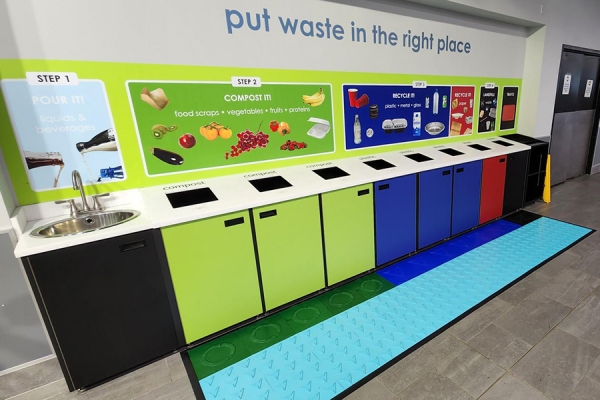 WasteFinder tactile mats on the floor can be felt underfoot, enabling individuals with disabilities to access the recycling sorting station in the student centre cafeteria.
WasteFinder tactile mats on the floor can be felt underfoot, enabling individuals with disabilities to access the recycling sorting station in the student centre cafeteria.
In designing a sorting station for recyclable materials and waste in the CAW Student Centre, accessibility was not an afterthought, says Cherie Gagnon, accessibility manager in the Office of Human Rights, Equity, and Accessibility.
“Accessibility was considered from the beginning to ensure that all who wish to participate can to the greatest extent possible,” she says. “Rather than an add-on, it was naturally embedded into the design.”
The centralized sorting station in the cafeteria will enable patrons to easily put their waste in the right place, with brightly coloured and labelled bins identifying materials as destined for recycling as paper or metal or plastic containers, for composting organic materials, or landfill as waste.
In front of the bins, “STILSolutions - Sustainability Through an Inclusive Lens” WasteFinder mats provide both tactile and visual information to assist individuals with disabilities to dispose of their waste independently and effectively. These accessible tactile mats were created by Laurier student Hilary Scanlon addressing a personal, and day-to-day problem.
The mats can be felt distinctly underfoot even when using mobility devices. There are five designs: a vicinity indicator that lets individuals know when they’re within a certain distance of the waste disposal unit, blue with a triangle pointing toward the bins indicating container recycling, blue with a triangle pointing away for paper recycling, green circles for organic collection, and black square for waste headed to landfill.
“Many experts are recognizing the connection between accessibility and sustainability,” Gagnon says. “Using both of these lenses from conception through to the final product creates the strongest outcomes which contributes to an inclusive and responsible campus.”
